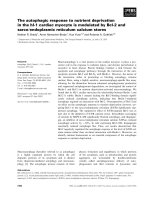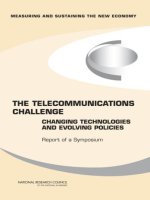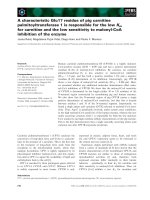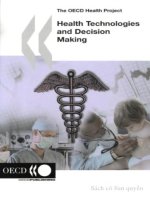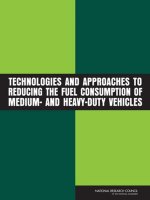Editorial: Models, technologies and approaches toward widening the open access to learning and education
Bạn đang xem bản rút gọn của tài liệu. Xem và tải ngay bản đầy đủ của tài liệu tại đây (250.03 KB, 10 trang )
Knowledge Management & E-Learning, Vol.8, No.1. Mar 2016
Knowledge Management & E-Learning
ISSN 2073-7904
Editorial: Models, technologies and approaches toward
widening the open access to learning and education
Rachid Benlamri
Lakehead University, Ontario, Canada
Fanny Klett (IEEE Fellow)
German Workforce ADL Partnership Laboratory, Germany
Minhong Wang
The University of Hong Kong, Hong Kong
Recommended citation:
Benlamri, R., Klett, F., & Wang, M. (2016). Editorial: Models,
technologies and approaches toward widening the open access to learning
and education. Knowledge Management & E-Learning, 8(1), 1–9.
Knowledge Management & E-Learning, 8(1), 1–9
Editorial: Models, technologies and approaches toward
widening the open access to learning and education
Rachid Benlamri
Faculty of Engineering
Lakehead University, Ontario, Canada
E-mail:
Fanny Klett*, IEEE Fellow
Director, German Workforce ADL Partnership Laboratory, Germany
E-mail:
Minhong Wang
KM&EL Lab, Faculty of Education
The University of Hong Kong, Hong Kong
E-mail:
*Corresponding author
Abstract: This special issue is devoted to novel models and technologies as
well as current methodical approaches and best practices in the field of Open
Learning and Open Education as enablers of personal growth, social inclusion,
open innovation, and sustainable economic development in the challenging
conditions of globalization and world-wide competition in productivity and
services. The Open Access to Learning and Education embraces not only
various technologies, such as mobile and intelligent technologies, content and
data management, user-centered design, but also diverse directions of use, such
as e-learning and training, organizational development, Massive Open Online
Courses, special needs education, all building an excellent basis for various
educational and business arrangements that widen the learning and education
opportunities for all people around the globe. Against this background, this
special issue demonstrates the immense speed and relentlessness of the Open
Access concept growth presenting a wide range of examples toward supporting
competency and skills development to ensure highly capable human capital,
and solve individual, business, urban, demographic, health as well as social
inclusion issues in today’s highly demanding digital economy environment.
Keywords: Open access; Open education; Open learning; Higher education;
Special needs education; Healthcare management; Knowledge management;
Open innovation
Biographical notes: Prof. Rachid Benlamri is a Professor of Software
Engineering at the Faculty of Engineering at Lakehead University, Canada. He
is the head of the Semantic Web and Mobile Computing Lab at Lakehead
University. His research interests are in the area of Semantic Web, ContextAware Computing, Ubiquitous Computing, and Mobile Knowledge
Management. He supervised over 70 students and postdoctoral fellows. He
served as keynote speaker for many international conferences. Prof. Benlamri is
2
R. Benlamri et al. (2016)
an Associate Editor for the International Journal of Ubiquitous Learning, and
member of the editorial board of many other journals such as the International
Journal of Learning Technologies, the International Journal of Mobile
Communications, the International Journal of Emerging Technologies in Web
Intelligence, and the International Journal of Electronic Government.
Dr. Fanny Klett assumed the Directorship of the German Workforce Advanced
Distributed Learning Partnership Laboratory, which is run in cooperation with
the US Government, in 2009. Prior to this position, she has been with leading
research institutions in principal positions. Fanny Klett is regularly invited as
Visiting Professor and Distinguished Lecturer at universities worldwide. Her
research involves advanced ICT solutions in the areas of information, data and
content management, competency and job performance management,
assessment, knowledge management, data mining as well as metadata,
repositories, data fusion and interoperability. Dr. Klett actively works in
standardization bodies, such as IEEE Learning Technology Standards
Committee, US Advanced Distributed Learning Initiative, and is CEN WS-LT
LTSO expert. She chaired and served on more than 30 conference planning and
program committees of UNESCO, IEEE, APSCE, etc. Fanny Klett is
associated editor of IEEE publications and serves on the editorial boards of
many international journals on advanced technology themes including IEEE
Transactions on Education, and IEEE Educational Technology and Society
Journal. In addition, she assists various governmental research sponsoring
organizations worldwide, as an expert. Dr. Klett is IEEE Fellow. She is
Member of the Sponsor Executive Committee and Secretary of the IEEE
Learning Technology Standards Committee, and Member of the Council and
the Academic Board of the European Association for Education in Electrical
and Information Engineering.
Dr. Minhong (Maggie) Wang is an Associate Professor with the Faculty of
Education at the University of Hong Kong, and Director of the KM&EL Lab.
She was a visiting scholar at Harvard Graduate School of Education, University
of Cambridge, and MIT Sloan School of Management. Her recent studies focus
on thoughtful design and implementation of computer-based learning
environments, and analysis of learning in such environments in the sectors of
workplace learning, higher education, and school education. Her research aims
to provide learners with necessary support to achieve high levels of autonomy,
confidence, and performance when they are faced with challenges, for example
in performing authentic tasks to solve complex real-world problems and
constructing knowledge from the problems. She is the Editor-in-Chief of
Knowledge Management & E-Learning, and Associate Editor of Information &
Management. She also serves on the editorial board of several international
journals including Educational Technology Research and Development, and
Educational Technology & Society. More details can be found at
/>
1. Introduction
Learning is central to economic success and social cohesion, especially with the
challenges of the rapid technological changes and global digital economy. Open Access
to learning and education is key to increasing participation and achievement in learning.
Equity and viability dictate that all should have the opportunity for access to learning,
and public policy must be redirected towards widening participation in further education
with special focus on those who are unemployed, economically inactive, and health
Knowledge Management & E-Learning, 8(1), 1–9
3
impaired. The key concept in the right to education is access to the means to gain
knowledge, skills and competencies to learners at all ages. Recent advances in
Information and Communication Technology (ICT) played an important role to enable
access to various sources of information, data and knowledge. However, little progress
has been made toward developing new pedagogical approaches and models for Open
Access learning across the diversity of social, cultural and educational backgrounds.
In 2002, UNESCO adopted the term Open Educational Resources (OER) to refer
to the “open provision of educational resources enabled by ICT, for consultation, use and
adaptation by a community of users for non-commercial purposes” (Albright, 2015).
OER are “teaching, learning and research materials in any medium, digital or otherwise,
that reside in the public domain or have been released under an open license that permits
no-cost access, use, adaptation and redistribution by others with no or limited restrictions.
As emphasized in the recently published Paris OER Declaration by UNESCO (2012), the
term "open" generally means that the resource can be accessed and used by everyone in a
non-discriminatory manner, and also that it can be adapted, modified, and shared. More
specifically, the characteristic of openness addresses the removal of technical, economic,
and legal barriers to gain access to and make use of OER. Furthermore, The ‘4-A
Conceptual Framework’ by Tomasevski (2001) emphasizes rights to as well as rights in
education in four aspects of access as follows:
Availability. This aspect concerns the availability of learning institutions and
instructors, including Open Universities and virtual learning centers;
Accessibility. This aspect refers to the elimination of legal, administrative and
financial barriers, as well as discriminatory denials of access;
Acceptability. This aspect correlates with meeting minimum standards for
quality, safety and environmental health; using an acceptable language of
instruction; and
Adaptability. This aspect addresses the obligation to adapt to the unique needs
and cultures of a wide range of constituents such as minorities, indigenous
people, workers, people with disabilities and migrants.
The phenomenon of OER is part of a broader trend toward participatory
innovation processes and Open Access to knowledge, embodied in several movements
that are committed to the "open", including the Open Access (OA) movement, the Open
Source Software (OSS) movement, and the Open Licensing (OL) movement
(Mikroyannidis et al., 2016). Open licensing is built within the existing framework of
intellectual property rights as defined by relevant international conventions and respects
the authorship of the work. Creative Commons licenses play a significant role in making
“openness” possible, and it has a particular interest in and engagement with educational
materials. Ahrash Bissell, Director of the CC-Learn initiative of Creative Commons
describes the effort as follows: “Open Educational Resources (OER) represent the efforts
of a worldwide community, empowered by the Internet, to help equalize the access to
knowledge and educational opportunities throughout the world. OER are released under
an intellectual-property license that permits their free use or customization by others. It is
the granting of freedoms to share, reprint, translate, combine, or adapt that makes them
educationally different from those that can merely be read online for free” (Bissell, 2005).
Creative Commons licenses are currently being used in a broad range of open educational
content projects worldwide, including the notable Open Course Ware (OCW) from MIT.
Launched in 2001, MIT OCW is usually considered as a key initiator of the OER
movement and the subsequent international OCW Consortium created in 2005.
4
R. Benlamri et al. (2016)
The OER movement has also played a key role in improving both, quality and
quantity of free online courses. Over the last few years, the MOOCs (Massive Open
Online Courses) phenomenon has become widely acknowledged as crucial for freely
accessible high quality courses provided by many higher education institutions, including
elite universities such as MIT and Stanford. Access to such high quality free courses has
allowed students to obtain a level of education that many only could dream of in the past
(Yousef, Chatti, Schroeder, Wosnitza, & Jakobs, 2014). Through MOOCs, hundreds of
thousands of students from developing countries have now access to elite universities
without paying tuition or collecting a university degree (Brown, 2013). In recent years,
topics around MOOCs are extensively discussed across a range of academic publications
from different theoretical and practical perspectives, including numerous
implementations and design concepts of MOOCs.
MIT OCW, the OCW Consortium, MOOCs, and many others dealing with open
textbooks, instructional videos, and a broad range of materials at repositories and digital
libraries rely on Creative Commons Licensing. Though most OER providers are
academic institutions, corporations have also started to share their training courses
through OER (Grayson, Coughanour, & Cannon, 2007). OER are now available in
multiple languages in portals and gateways, institutional repositories, subject
portals/collections and community-developed content (Yousef et al., 2014). OER
repositories include Merlot ( Curriki ( />OER Commons ( and Connexions ( to
name just a few. Creative Commons is also partnering with academic publishers of
educational content.
An important key issue in financial sustainability is whether the production of
OER uses a producer-consumer model or a co-producer model (OECD, 2007). A
producer-consumer model is typically more centralized. This is usually a form of
institutional publishing such as the MIT OCW initiative. This model usually has higher
costs associated with the publishing staffing and workflow for providing quality review,
production consistency and copyright clearance of third-party resources. A co-producer
model however, is typically decentralized and based on a community of volunteers that
work together to create resources for the community. Examples of this include LabSpace
of the Open University in the UK and WikiEducator of the Commonwealth of Learning.
Many OER initiatives today are a form of institution-based publishing using the
producer-consumer model.
OER and online learning, mainly provided through Open Universities, may help
provide scalable solutions to address the education gap in society, independently of a
geographic location. OER and Open Universities can increase access to knowledge
through amplified opportunities for learning, improved availability of cost-effective
resources; boosting quality and variety in resources; and through bridging formal and
informal learning (Venkaiah, 2007). The Open University of the United Kingdom and the
Open University of the Nederlands are early pioneers with OER in this direction.
Innovative Concepts for new institutions using online learning and OER have been
proposed. Fay and Sjogren (2007) have outlined an open source online degree-granting
institution. They rely on OER to lower costs and increase scalability by creating a new
publishing mechanism for faculty while it creates a global online open curriculum, with
many variations, to be openly shared around the world. In another model, Taylor (2007)
describes a concept for an Open Courseware University. In this concept, selflearners
using OER from OCW Consortium members would be supported by volunteer tutors and
gain credit on-demand from providing institutions. Credits earned in this way from
Knowledge Management & E-Learning, 8(1), 1–9
5
various institutions would be aggregated by a new mechanism that would award
accredited degrees.
An additional effect of the Open Education movement and OER is the stimuli
arising from several participants of a same community of interest, where people become
part of a collaborative co-creation process. Viewed this way, active “creative spaces”
arise, namely innovation communities, where people can exchange their ideas and share
knowledge without restriction. These processes not only facilitate collaborative reflective
learning, but stimulate open innovation activities. This aspect of the Open Access to data
and knowledge is broadly exploited in organizational structures in terms of knowledge as
well as innovation management and organizational development (Siemens, 2015).
The various initiatives that evolved from Open Learning to Open Access
education make us aware that technology and infrastructures are the enabling aspect of
these concepts. There is no single approach to Open Learning, and no one-size-fits-all
approach to Open Access education. Reflecting the research and application directions
introduced in this section, the next section contains an overview of the contributions in
this special issue that present original technological as well as methodical approaches by
addressing the key challenge of Open Education, namely exploiting data and knowledge
resources and improving personal, organizational, business, and urban development as
well as social inclusion processes toward a socio-economic impact and benefit for all
stakeholders involved in these processes.
2. Preview of papers
This special issue of the KM&EL International Journal is dedicated to recent chances,
concerns as well as best practices affecting a rapidly increasing number of organizations
that apply the Open Access concept. It reveals current experience in shaping,
implementing and delivering the new generation of formal, non-formal and informal
education, namely Open Education. The special issue covers leading Open Access
research and development from the United States, Italy, Austria and the United Kingdom,
Japan, and Iran, and addresses tangible implementations spread over developed and
developing countries. The distinctive approaches of the multi-faceted Open Access
concept refer to applications in the fields of learning, competence and skills development,
health management, organizational management, knowledge management, integration
and reuse of OER, MOOCs as well as Open Access learning systems for people with
disabilities, aligned toward a shared goal, namely the improvement of the conditions for
individual, business and social wealth by equally delivering knowledge and education for
all.
The first paper presented in this special issue, is devoted to illustrating the
fundamental role that OER increasingly play in education and training processes on a
global basis. Mosharraf and Taghiyareh provide an original overview of opportunities
and advantages resulting from the use of OER by distinguishing between three groups of
eLearning stakeholders, namely learners, teachers, and educational institutions. The
clarification of the roles, intentions, and driving forces behind those stakeholders in the
Open Access education processes is a unique contribution toward the current and future
investigation of the OER utilization from the technological, personal, economical,
historical, cultural, and social perspectives. Moreover, this fundamental observation
paper discusses open questions related to the identified limitations and challenges that
6
R. Benlamri et al. (2016)
affect the design as well as the distribution of OER in today’s rapidly transforming global
educational environment.
Bourrie, Jones-Farmer, and Sankar set a special focus on innovation in formal
education in the United States by investigating in a non-traditional study variables that
influence the intention of faculty members at electrical engineering and computer science
ABET certified programs to adopt new educational innovations, such as Open Access to
learning, and conclude on the conditions for a widespread effect of this concept. Toward
this goal, the authors investigate: 1) the characteristics of the educational innovation that
meaningfully impact the intention to adopt educational innovations, 2) the variables that
model the readiness of faculty members intention to adopt educational innovations, and 3)
the characteristics of the innovations that form the correlation between faculty readiness
and intention to adopt the innovations. The research study represents a crucial source for
innovative Open CourseWare developers and institutions demonstrating that ease of use,
and care about student learning outcomes directly influence intention to adopt
educational innovations. Against this background, the authors call for new grant
strategies to ensure a broad utilization of easy-to-use Open Learning technologies.
Devoted to the context of primary school education in correlation with an Open
Learning approach, the third paper investigates the proper combination of the serious
games and Open Learning advantages to enhance the learning abilities of young children.
Lunn, Khalaf, Hussain, Al-Jumeily, Pich, and McCarthy spot in a research study on the
movement initiated in the United Kingdom, where from the age of 5, children will be
taught computing knowledge and skills by stressing on algorithms, storing digital content,
creating and testing simple programs. The authors seek for innovative ways to design an
Open Learning environment based on serious games, which offers interpreted and shared
experience by creating a genuine platform for user generated experience. Their major
contribution concerns the identification of the success factors for future developments
with regard to ensuring a direct experience for learners alongside with increasing their
learning ability, excitement and entertainment and providing immediate feedback. The
research described in this paper represents a valuable support to all researchers and
practitioners dealing with Open Learning environments for early child education.
In view of the present digital economy, the fourth paper leaves the educational
grounds and demonstrates the utilization of Open Learning in the business reality to
enable professional development. Mwaikambo and Dolphyne present the research and
results from applying an Open Learning approach to health care development in Ghana
by incorporating mobile technology utilized to access OER. The lessons learnt clearly
show the benefits of a widely accessible open content, on the one hand for individual
professional development, namely health workers, who need to continually update their
skills and knowledge throughout their adult lives, and on the other hand for
organizational development, namely governments, regulatory bodies, and professional
associations to more easily and effectively implement high quality continuing education
programs. Furthermore, the authors systematically investigate the OER challenges and
issues by referring especially to the adaptation process of Open Learning materials in
terms of technical relevance to the target audience, fitting local context as well as
appropriateness for a mobile phone delivery. In following this line, Mwaikambo and
Dolphyne state a demand for a strong collaboration between all stakeholders engaged in
the professional development to effectively understand one’s target audience along with
the culture of the Open Education movement.
Devoted over again to child education, the fifth paper adds a new focus –special
needs education– and provides an original contribution to mastering the delivery of
Knowledge Management & E-Learning, 8(1), 1–9
7
special needs education in case of speech and language deficiency. Al-Jumeily, Hussain,
Abuelmaatti, Fergus, and Lunn demonstrate innovative research that goes far beyond
existing solutions designed as an exact digital representation of the current paper-based
methods for special needs education. Utilizing Internet and mobile technology, the
authors create a modern Open Learning system that constitutes an evolution in language
learning in the context of understanding spoken instruction, and benefits from open
content with novel presentation of keywords and associated context, whereas the learning
algorithm is derived from the field of applied computing in human biology using the
concept of spaced repetition. Moreover, this paper serves as a guideline for shaping a
novel augmentation of the memorization process for special needs education in a global
Open Education setting.
The sixth paper addresses once more the use of Open Learning in the business
environment by targeting particularly the challenging organizational development toward
participatory knowledge management. Stary presents a unique concept for understanding
process design as Open Learning facility. The author provides evidence of the high
demand for a sufficient support for stakeholders to actively participate in developing
work knowledge and implementing changes after reflecting the impact on the level of
operation. Stary’s crucial contribution refers to defining, investigating as well as
summarizing the effects of the features, constitutive elements and processes of the open
organizational learning processes. The research presented in this paper introduces a novel
way of defining Open Participatory Learning Infrastructures from an OER and Open
Access perspective on the individual and collective level by embracing semantic
technologies, social media, and contextual design to trigger and implement Open
Learning processes.
Following the OER movement, the MOOCs have become an essential factor for
adding a new viewpoint on the education and knowledge development by allowing more
people to access education, irrespective of their learning history, the content delivery
mode and a standard physical presence at lectures. The next two papers deal with this
challenging MOOCs phenomenon mirrored on both, higher education and business
organization processes, from a market-relevant innovation management and
entrepreneurship perspective.
Cirulli, Elia, Lorenzo, Margherita, and Solazzo demonstrate a beneficial
application of MOOCs toward the design and provision of personalized learning paths
that serve competencies development processes and the formation of entrepreneurial
behaviour in the technology entrepreneurship domain. The authors exploit the design
science approach to create a modern platform for the MOOCs delivery along with a set of
experimental courses and user guidelines. They constructively identify a two-fold
dimension of the designed MOOCs system, namely a process-oriented view ‒related to
the roadmap applied to transform an idea into an entrepreneurial venture, and a
technology-oriented view ‒based on the platform and software components used for the
system implementation. The inherent roadmap purposefully directs the processes of
course classification, competence mapping as well as learning gap analysis, and selfevaluation of the status of the entrepreneurial journey together with offering appropriate
recommendations in terms of activities to accomplish and courses to access. The system
is evaluated in a trial setting to obtain feedback for the iterative system design
approaching future real time monitoring of the learners’ progress interrelated to
individual performance in addition to social network dynamics.
Siddike and Kohda also address the incessant societal and business demand for
creation, adoption, and diffusion of innovation, which is commonly seen as the driver for
8
R. Benlamri et al. (2016)
economic value. More specifically, the novel research described in this paper drives the
development process of social innovation in learning and education by proposing a new
service system as well as a new social innovation in terms of increasing literacy through
the application of MOOCs. The authors thoroughly illustrate the MOOCs vast potential
and opportunities for the initiated expansion of social innovation in a developing country
like Bangladesh where rural environments are in the majority but mobile and Internet
connections are available on a broad basis. The authors make trends visible, observe
dynamic factors, develop a model for social innovation in education, and show how it can
facilitate social innovation by obtaining access to additional educational resources,
setting up the basis for better future employment as well as self-employment
opportunities, and establishing a bridge to innovative education provider organizations
and donor agencies. In following this line, Siddike and Kohda not only detect the
distinctive features of this model for a developing country but also its added value that
allows for sustaining and scaling the social innovation and opening up various
possibilities for different organizations to collaborate with the social entrepreneurs,
considering also feedback on the user acceptance and satisfaction toward future content
adaptation demands. By applying open educational technologies, the social enterprises
can take the advantage of MOOCs to ensure higher literacy to rural people, including
computing skills, and financial knowledge, and moreover, the institutionalization of
social innovation, whereas the findings are applicable to many other developing countries
showing similar education demand.
3. Conclusion
This special issue of the KM&EL International Journal depicts unique research and
recent results about the utilization of the Open Access approach and open educational
technologies around the globe, providing valuable experiences from developed as well as
developing countries. It serves as an essential source toward mastering innovative
educational change management and education transformation at national and
international campuses, and modern business organizations, and designing a sustainable
future for the people. The findings of the studies presented in the distinguished papers
provide indispensable insights on valuable practices toward models, technologies and
approaches to effectively supply the interrelationship between learners, and education
and business stakeholders toward successfully shaping personal as well organizational
development by taking advantage of the remarkable popularity and acceptance of the
Open Access concept for learning and education delivery. The research outcomes are
fundamental for a broad audience of local, national and international educational experts
and leaders, open innovation communities, system developers, content providers,
repository managers as well as academics, researchers and practitioners, involved in
strengthening education, the socio-economic development and the quality of life for
people on a global scale.
References
Albright, P. (2005). Final forum report. The Internet Discussion Forum on Open
Educational Resources, Open Content for Higher Education. Retrieved from
/>f/OER+Forum+Final+Report.pdf
Bissell, A. (2007). Some guiding principles for legal and technical interoperability in
Knowledge Management & E-Learning, 8(1), 1–9
9
OER. In Proceedings of the Open Education 2007: Localizing and Learning.
Brown, S. (2013). Back to the future with MOOCs? In Proceedings of the Int. Conf. on
ICT in Education (ICTE’2013) (pp. 237–246).
Fay, J., & Sjogren, J. (2007). The open source online university. Panel conducted at The
Fourth Annual Conference of Learning International Networks Consortium (LINC),
Amman, Jordan.
Grayson, C., Coughanour, D., & Cannon, A., (2007). Open for business: Open education
in the corporate world. In Proceedings of the Open Education 2007: Localizing and
Learning. Logan, UT.
Mikroyannidis, A., Domingue, J., Pareit, D., Vanhie-Van Gerwen, J., Tranoris, C.,
Jourjon, G., & Marquez-Barja, J. M. (2016). Applying a methodology for the design,
delivery and evaluation of learning resources for remote experimentation. In
Proceedings of the EDUCON’2016. Philadelphia, PA, USA. Retrieved from />OECD. (2007). Giving knowledge for free: The emergence of open educational resources.
Retrieved from />Siemens. (2015). Open innovation: Fertile ground for innovations. Retrieved from
/>Taylor, J. C. (2007). Open courseware futures: Creating a parallel universe. e-Journal of
Instructional Science and Technology, 10(1): 1.
Tomasevski, K. (2001). Human rights obligations: Making education available,
accessible, acceptable and adaptable. Right to Education Primers (No. 3), Swedish
International Development Cooperation Agency. Retrieved from />UNESCO. (2012). 2012 Paris OER Declaration. World Open Educational Resources
(OER)
Congress.
UNESCO,
Paris.
Retrieved
from
/>0OER%20Declaration_01.pdf
Venkaiah, V. (2007). Localizing open educational resources for higher education in India:
A consortium model. In Proceedings of the Open Education 2007: Localizing and
Learning. Logan, UT.
Yousef, A. M. F., Chatti, M. A., Schroeder, U., Wosnitza, M., & Jakobs, H. (2014).
MOOCs: A review of the state-of-the-art. In Proceedings of the 6th Int. Conf. on
Computer Supported Education (CSEDU’2014) (pp. 9–20).


